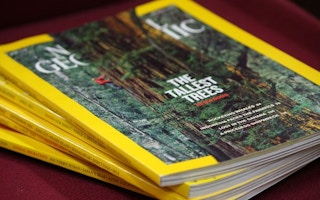In an attempt to ‘walk the talk’, the National Geographic Society (NGS) has begun including recycled fibres in the pages of its iconic magazines as part of its sustainable supply chain commitment.
To continue reading, subscribe to Eco‑Business.
There's something for everyone. We offer a range of subscription plans.
- Access our stories and receive our Insights Weekly newsletter with the free EB Member plan.
- Unlock unlimited access to our content and archive with EB Circle.
- Publish your content with EB Premium.
The United States-based publisher, which has led many scientific research and explorations around the world since 1888, announced on Thursday it is piloting to use five per cent post-consumer recycled fibre in the pages of its National Geographic magazine, National Geographic Kids, and National Geographic Little Kids. It also plans to continuously test the viability of papers with increased recycled content.
“For National Geographic, our goal – and our challenge – is to balance our desires to utilise as high a percentage of recycled fibre as possible, maintain the highest quality and aesthetic standards, produce affordable products and minimise our impact on the environment,” said Stephen Hughes, National Geographic’s vice president for global sourcing.
“
Recycled fibre is superior to virgin fibre in 14 out of 14 environmental categories, such as energy use and greenhouse gas emissions
The move is the result of a study conducted by NGS in collaboration with environmental groups Green America and the Natural Resources Defense Council (NDRC) in 2011, which assessed the impact of NGS’s paper use and how it can reduce its environmental footprint.
The lifecycle assessment, conducted by a third party provider and released earlier this March, revealed that recycled fibre is superior to virgin fibre in 14 out of 14 environmental categories such as energy use and greenhouse gas emissions.
Five per cent may not be a lot, but testing this level of post-consumer recycled content in the particular coated paper stock that NGS uses is an important first step, Darby Hoover, NDRC’s senior resource specialist, stated in his blog.
Hoover stressed that if National Geographic can continue to captivate their audience in print by using recycled material, anyone can.
“By adding recycled fibre into their magazines, National Geographic is joining a growing movement that can help ensure the world’s forests can live on the pages of their magazine—instead of in them—for years to come,” he added.
“
Through its Better Paper Project, Green America found that in over 15,000 magazine titles in the US, only about three per cent are regularly using recycled paper.
In an industry where majority still clings to virgin pulp, the move is a game changer, said Green America. Papers made of virgin fibres continue to dominate the paper manufacturing industry, noted the group’s project director Frank Locantore.
Through its Better Paper Project, Green America found that in over 15,000 magazine titles in the US, only about three per cent are regularly using recycled paper.
The carbon footprint of the industry could reach to an equivalent of more than 7.2 million metric tonnes of CO2 each year, or the annual greenhouse gas emissions of over 1.5 million cars, it explained.
NGS’s flagship publication, the National Geographic, has a circulation of about six million worldwide and is audited to be the seventh largest publication in the US, according to its website.
And that is why, “National Geographic’s recycled paper use is a tipping point for recycled paper in the magazine industry,” said Locantore.










